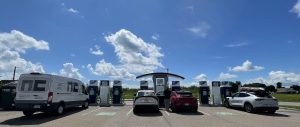Quebec’s electric vehicle charging strategy : An example to follow, according to Electric Mobility Canada
September 7, 2023
Montreal, September 7, 2023 – Electric Mobility Canada (EMC) notes the Quebec Electric Vehicle Charging Strategy released today is the result of rigorous work. “We […]Montreal, September 7, 2023 – Electric Mobility Canada (EMC) notes the Quebec Electric Vehicle Charging Strategy released today is the result of rigorous work.

“We congratulate the Government of Quebec on its leadership and vision. This exemplary strategy includes clear objectives and the measures needed to achieve them,” says Daniel Breton, president and CEO of EMC.
Here are EMC’s highlights of the Quebec Strategy for Electric Vehicle Charging:
A few statistics
- Quebec has around 39% of Canada’s public charging stations
- There are more than 9,200 public charging stations in 2023. More than 7,800 Level 2 charging stations and nearly 1,400 DCFC stations by various charging network operators are in service.
- 3.2 million Quebecers live in multi-unit dwellings.
- The Electric Circuit accounts for 60% of DCFC stations and 47% of L2 charging stations in Quebec.
- 18–20-month lead time for Hydro Québec to connect charging stations. Hydro Québec will work to respond to requests as quickly as possible.
The budget
- An additional $514 million for the period 2023 to 2028 on top of the $249 million already
announced (a tripling of the budget), including- $265 million for public stations
- $108 million for multi-dwelling buildings
- $35 million for heavy transportation
- $40 million for accommodation and tourist sites
- Continuation of the subsidy program for 4,500 L2 charging stations for municipalities in downtown areas, densely populated neighbourhoods, tourist sites and parks.
- $12.5 million enhancement to the workplace recharging program, so that charging stations can be used by customers.
- As of 2024, only connected charging stations will be eligible for government financial support.
- For multi-unit buildings, financial assistance will be conditional on the acquisition of optimal energy management equipment.
2030 targets
- 110,000 public L2 charging stations by 2030
- 6,700 DCFC stations by 2030, including 2,530 by the Electric Circuit
- 1 public charging point for every16 electric vehicles by 2030
- 600,000 (35%) parking spaces in multi-dwelling buildings will be adapted for electric vehicles
- 350,000 parking spaces upgraded in multi-dwelling buildings already built and 250,000 according to new building standards
- 1.74 million residential charging points for 2 million electric vehicles by 2030
- 145,000 electric vehicle owners will not have access to home charging (“charging orphans”) – $1 million for Hydro Québec to work on solutions
The regulatory framework
- Adoption of regulations in 2024 to provide for the installation of charging infrastructure in new multi-unit buildings of 5 dwellings or more.
- Future regulatory framework on the right to charge
- Framework inspired in whole or in part by CSA’s work on network accessibility and reliability
- Compliance with standards will eventually become a condition for obtaining financial assistance under government programs.
- Within a few months: kWh billing for Electric Circuit DCFC stations.
Other notes
- Study on off-grid charging needs
- Pilot project for off-grid charging
One shortcoming
- The strategy does not include measures for single-family homes 40 years or older with insufficient
electrical capacity (100-amp panel) to add a charging service.
RELEVANT LINKS (in French)
- Québec strategy for electric vehicle charging
- Québec is investing half a billion dollars and plans to install more than 116,000 public charging stations by 2030 (Press release)
Consult the PDF version here
